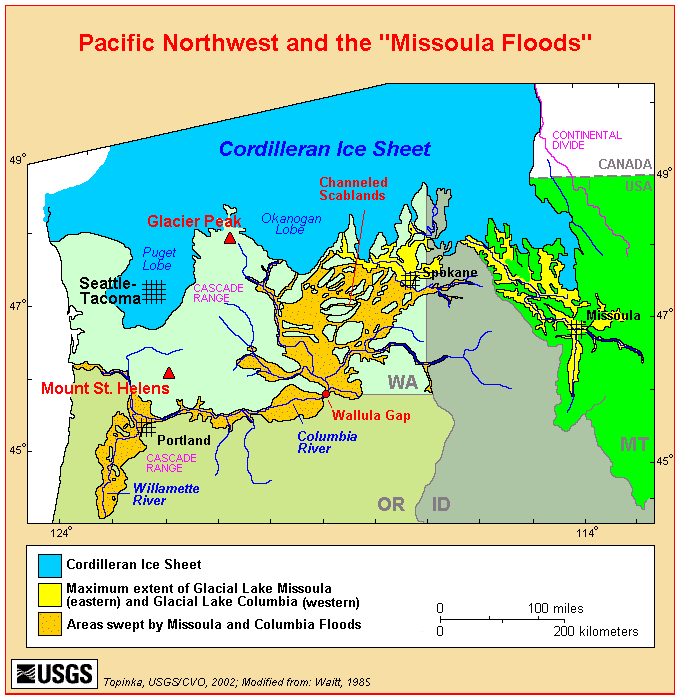The Volcanoes of
Lewis and Clark
Lewis and Clark
| The Cordilleran Ice Sheet and Missoula Floods |

|
|
The Ice Age:
With the beginning of the Pleistocene time, about one million years ago, cooling temperatures provided conditions favorable for the creation of great sheets of moving ice. Thus began the Ice Age. Glacial Lake Missoula: At the end of the last Ice Age, a finger of the Cordilleran ice sheet crept southward into the Idaho panhandle, forming a large ice dam that blocked the mouth of the Clark Fork River, creating a massive lake 2,000 feet deep and containing more than 500 cubic miles of water. Glacial Lake Missoula stretched eastward for some 200 miles and contained more water than Lake Erie and Lake Ontario combined. When the highest of these ice dams failed, lake water burst through, shooting out at a rate 10 times the combined flow of all the rivers of the world. This towering mass of water and ice literally shook the ground as it thundered toward the Pacific Ocean, stripping away hundreds of feet of soil and cutting deep canyons -- "coulees" -- into the underlying bedrock. With flood speeds approaching 65 miles per hour, the lake would have drained in as little as 48 hours. Over time the Cordilleran ice sheet continued moving south and blocked the Clark Fork River again and again, recreating Glacial Lake Missoula. Over approximately 2,500 years, the lake, ice dam and flooding sequence was repeated dozens of times, leaving a lasting mark on the landscape. Glacial Lake Columbia: A lobe of the Cordilleran Ice Sheet descended into the Okanogan Valley, blocked the Columbia River, and covered 500 square miles of the Waterville Plateau west of Grand Coulee. The south terminus of the Okanogan lobe is clearly marked by an abrupt south limit of lumpy, rocky moraines. The ice-dammed Columbia River backed up to form Glacial Lake Columbia, a huge version of the lake now ponded by Grand Coulee Dam. Lake Columbia's overflow -- the diverted Columbia River -- occupied Grand Coulee between Ice Age Floods events. -- Excerpts from: U.S. National Park Service Website, Ice Age Floods, 2002 |
|
The Volcanoes of Lewis and Clark |
If you have questions or comments please contact: GS-CVO-WEB@usgs.gov
June/July 2004, Lyn Topinka
The Volcanoes of Lewis and Clark Home Page | CVO Home Page
